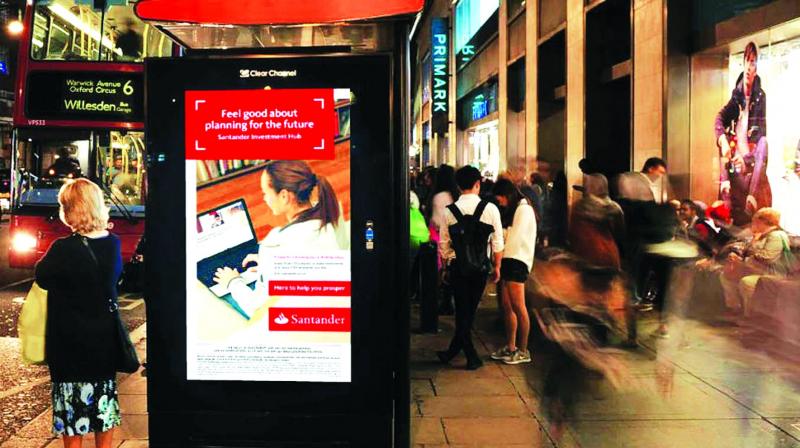Smart advertisements, too smart?

When British supermarket giant Tesco came to South Korea under the brand name HomePlus, it faced a disadvantage: It had too few stores, spread too thinly to take on the local competition. It did some research that showed that Koreans were among the most hard working people in the world: this left them little time and no inclination for the weekend scramble at supermarkets.
Tesco came up with solution that simultaneously closed the gap posed by their limited outlets — and leveraged the psyche of the average Korean customer, who was tech-savvy too. To create the solution Tesco turned to its Indian engineers at the Whitefield campus of Tesco Bengaluru. They created the Tesco Virtual Supermarket: consisting of posters of shelves stocked with goods pasted on the platform walls of Seonreung subway station in downtown Seoul. The displays illustrated in full scale, over 500 of the most popular products each with a Quick Response code. Passengers ‘shopped’ by scanning the QR codes of the items they want to buy using the Homeplus app on their smartphones. The app generated a shopping basket and a payment gateway. The goods ordered were delivered to customers at their home address even as they reached home. The Korean experiment was a huge success — and Tesco’s India team was soon replicating the virtual shop shelves for the company’s home country — UK. Soon Tesco launched ten virtual marts at the North Terminal departure lounge at Gatwick, an important commuter airport — there were four ‘refrigerators’ for perishable goods and six ‘cupboards’ for more long-lasting fare. Commuters who scanned and ordered their groceries on their way to work in the morning before noon were assured that the items would be home delivered the same evening. Tesco coined a new motto: “If people don’t come to the store, let the store come to the people.”
Smart billboards
All this is in the past — albeit futuristic and ‘Made in India’. But in the near future, marketing and advertising is all set to feel the garam hava of Artificial Intelligence and Machine Learning. The problem is that today’s consumer uses his or her mobile phone like an agni asthra, or like a digital Swiss Army Knife with multiple virtual blades to access multiple services. But more often than not, the technology tends to overwhelm rather than empower. Advertisers went overboard with huge Out-of-Home (OOH) digital bill boards that distract rather than inform. There is already a backlash and a message to advertisers: Less is more. As consumers we part with personal data every time we download a free app or sign up for a free Internet service. Most of us don’t care — but we do expect that companies use the data we have provided to replace the barrage of aimless marketing messages with a smaller number of more sharply targeted and relevant messages. Say hello, soon, to customised advertising in the digital age. Billboard-makers are now creating intelligent advertising that’s sharply targeted at individual passers-by or shoppers. Attention-grabbing content responds to consumers’ mobile phone activity or shared information networks. This is how it works:
You go to an mall, an airport departure area or a railway concourse. You log on to the free WiFi service. With that single act, ‘they’ know who you are, what your tastes are, your online shopping and reading history. You saunter to one of the many digital advertising kiosks to be found around you. When you get within five metres, the Artificial Intelligence-driven back end of the kiosk, has ‘recognised’ you. Last time you passed through Kochi airport, you had bought a Karlsburg shirt. The ad rolling on the kiosk quickly adjusts and flashes a message: a new range of Karlsburg linen shirts are in stock... do step in! If instead your past history shows you had bought a briefcase at the Hidesign store or a set mundu or dhoti at the MCR clothing store, the ad will quickly readjust, examine your last purchase and make some new suggestions. As you move away (hopefully a renewed customer!), the kiosk senses the next approaching passenger an prepares a new advertisement. Fiction? Today, yes. But it will be there is 2-3 years — in Kochi and every other Indian airport. It’s called dynamic digital Out of Home advertising and companies like LivePoster are rolling it out in the West. A Microsoft study concludes: “The future is “intelligent advertising” — advertising that understands individual consumers and can deliver tailored content at the right place, at the right time, and on the right platform. Brands capable of bringing the right content from the Internet to the fingertips (or even wrists) of consumers while intelligently avoiding “information overload” will be handsomely rewarded.”
AI is today tapping technology like 3-D and 360-degree video at AR/VR, to create amazing walk-thrus of famous places and heritage tourist attractions. A partnership between Google and the Archaeological Survey of India has seen 374 Indian museums and heritage sites transformed into virtual tours with stunning interior and exterior views. (To get a feel of how this works, see the 3-D walk through of Taj Mahal at Google Maps- Street View here ).
But here’s the danger: There is a point of technological over kill. Travel agencies and tourist bureaux are creating stunning online replications of destinations: You can actually walk along that beach in Bali or inspect that mountain resort hotel, room by room by swiping or moving your mobile phone... and thanks to WiFo or that HDMI or MHL port, you can blow up the 3-D imagery and view it on your TV screen. Will you then say: ‘OK let’s book and go there’? Or will you say “This is so real! I feel I’ve already been there, so I won't bother.” Smart advertising has huge promise. But there is such a thing as being over smart!
( IndiaTechOnline)

